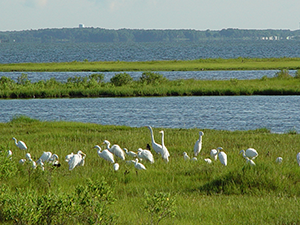Assateague's Wildlife
 Assateague Island is on the Atlantic flyway. Over 200 species of birds have been sighted here - from gulls to herons, egrets to eagles, even endangered peregrine falcons and snowy owls. Those most prevalent include osprey, herons, egrets, sandpipers, shorebirds, ducks, geese and other waterfowl.
Assateague Island is on the Atlantic flyway. Over 200 species of birds have been sighted here - from gulls to herons, egrets to eagles, even endangered peregrine falcons and snowy owls. Those most prevalent include osprey, herons, egrets, sandpipers, shorebirds, ducks, geese and other waterfowl.
Both whitetail and sika deer live on the island, although there is little competition between the two.
Sika deer originated in Asia and were brought to the island in 1923. They are more closely related to elk than our native whitetail. Sika prefer the thick marshlands to the more wooded areas that the whitetail inhabit. They reach heights of 2½ - 3 feet, can weigh between 70-90 pounds, and can make ten different sounds!
The ocean and bay surrounding the island teem with life. Dolphins are often seen frolicking in the waves of the ocean. Flounder, spot, sea trout, puffer, rockfish, croaker, red drum and bluefish are residents, and marlin and tuna can be found in deeper water offshore. Seals, whales, sand sharks and sea turtles have washed up on the shore. Staff at Assateague work with the National Aquarium in Baltimore and Oxford Labs when a beaching occurs – whether the animal is alive or not.
Summer visitors can see horseshoe crabs, terrapins, seahorses, spider crabs, flounder, eel, blue crabs, hogchoker, pufferfish, spiny boxfish, lookdown, mud snails, silversides, box turtles, surf clams, mud turtles, sea stars, mummichog, killifish, quahog, bay and sea scallops, perch, glass shrimp, and sea cucumbers, to name a few.
 The Wild Ponies
The Wild Ponies
Assateague Island is known as a place where wild horses roam freely. Visitors can see horses grazing in the marshes or up on the beach looking for a breeze to escape the heat of summer. Horses are safely viewed from a distance of at least a bus length (or 40 feet). Getting too close puts humans and horses into dangerous situations and is illegal. Always secure your food and keep it away from the horses by storing in your vehicle and using zippered bags and coolers with nylon straps when you do bring food to the beach. When taking photographs, always keep a safe distance (at least 40 feet away) and give horses their space. They can be unpredictable and may make sudden movements including charging, biting, and kicking. Let’s all work together to keep the “wild” in wildlife at Assateague State Park!